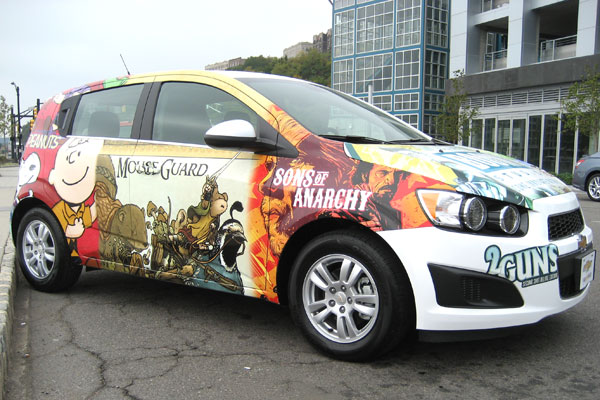Normally I don’t have any reason to drive an American made car, because after getting my license, I didn’t know anybody who owned one. Now, New York Comic Con gave me a reason to test out the Chevrolet Sonic since they were giving one away in a sweepstakes. The new 2014 Sonic will have a role in the new upcoming movie, Transformer 4, but details on who it is going to be is unknown. All we know so far is that it will be the RS variant. That is all I needed to push me to get behind the wheel.
There are 4 different variants of the Sonic with two engines that produces the same power, which may seem weird to most people considering it is a 1.8L vs. a 1.4L Turbo. The two engines are so different from each other that it becomes difficult to choose which engine to get for your Sonic (bar the LS model since it only gets the 1.8) even though they produce the same power. Let’s go through the differences. The main difference is $700 more for the 1.4L turbo but you get a good 5-mpg more for both city and highway. We do know that sticking a turbocharger on a small engine will produce as much power as a bigger engine and retain the fuel efficiency of a small engine. It also produces more torque, and both power and torque are available at lower engine speeds for a quicker acceleration. However, with every good side there is a bad side, and it comes in the form of turbo lag. I had written about turbocharged cars before and spoke about lag, but didn’t go into details. The turbocharged 1.4L gets this lag as the turbocharger needs enough exhaust gas to get the turbine up to speed for compressing air, and the compressed air will contain a higher oxygen ratio so the same amount of fuel can be burned more thoroughly for more power. The process of pressurizing the air takes time since engines don’t produce a lot of exhaust gas while idle. Some professional drivers still prefer naturally aspirated engines, or those without aid from turbo and superchargers, due to the immediate response from the driver and accelerator.
Enough about engines – let’s get to know how the Sonic drives. The car has great suspension, giving a sporty feel while absorbing bumps like you are rolling around on a marshmallow. The front seats are as expected in a compact hatchback, which is not much of an expectation, and the back seats are quite stiff and hard. I was not sitting in the back for long and I am glad I didn’t have to. It is not a tight squeeze, but taller people might have a problem sitting in the back without developing neck problems. There is a sense of cheapness in the car, as the materials seems like they were taken out of the trash from a plastic factory, but the car costs less than $20K with plenty of fine standard equipment, such as the XM radio and OnStar support. With all that comfort and safety equipment attached on the suspension, the Sonic does nicely in corners as well. Body roll is barely noticeable and steering is very responsive without causing a sweat. The steering was tight during high speeds, while small adjustments at low speeds still resulted in a decent turn. It never felt so good to park a car. This car kind of take cares of you, and driving it will not be tiring even for long stretches of time.
Overall, the 2014 Chevrolet Sonic is a good car at a great price. The only complaint I have would be the cheap feel of material inside the cabin. It is like the inside of the car is still stuck in the 19th century with 20th century technology attached, and it is not a good mix. Once you get over the horrible sight, take the car for a long drive down the Garden State Parkway to the shores, and you will be happier because you saved more money for getting the Sonic.
I thank Walt Pagurek at Royal Chevrolet on Route 22 East in Bridgewater for his help and excellent service.

by Xavier Poon




























